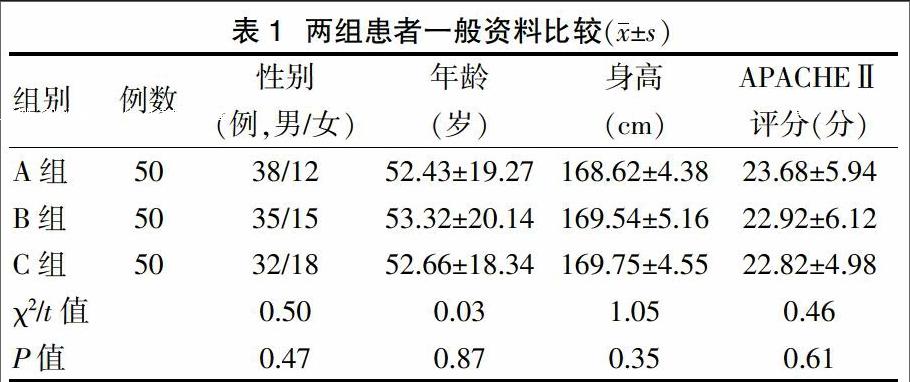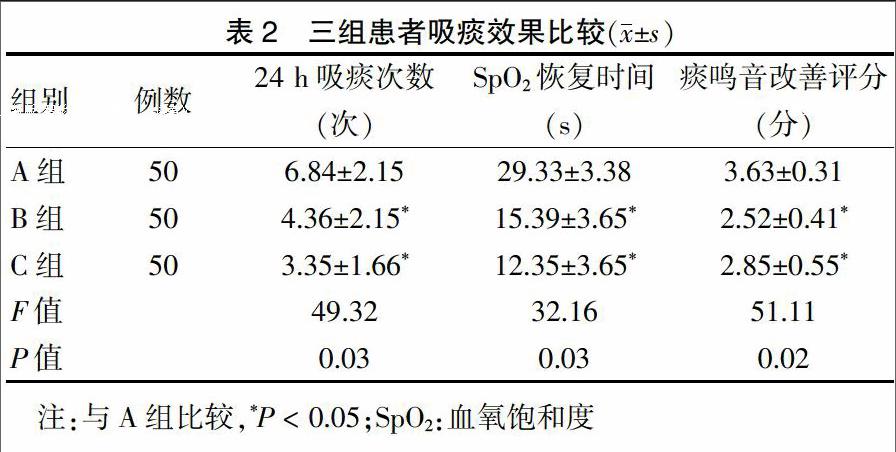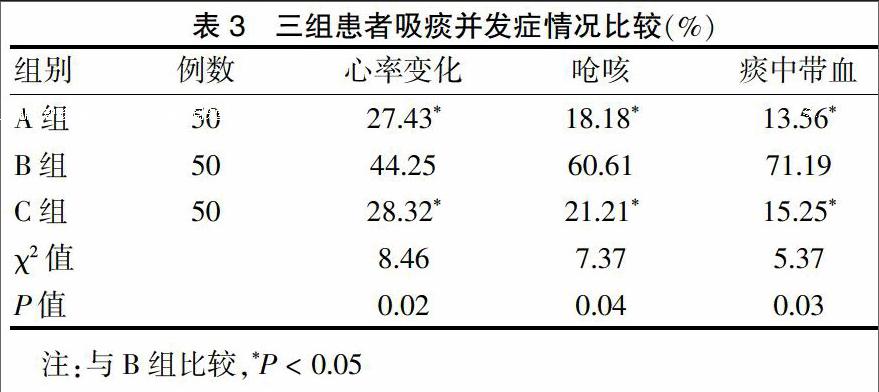不同吸痰深度密闭式吸痰法在外科ICU机械通气患者中的应用效果比较
梁娟+胡雪慧



[摘要] 目的 探讨不同吸痰深度密闭式吸痰法在外科ICU机械通气患者中的应用效果。 方法 选择2015年5月~2016年12月于第四军医大学西京医院外科综合ICU接受机械通气治疗的患者150例,采取随机数字表法分为三组,每组50例。A组吸痰管插入深度等于气管插管长度;B组吸痰管插入气道遇阻力后上提1~2 cm;C组吸痰管插入深度达气管插管长度后再插入1 cm,比较三组患者24 h吸痰次数、血氧饱和度恢复时间、痰鸣音改善评分及并发症发生情况。 结果 三组患者24 h吸痰次数、血氧饱和度恢复时间、痰鸣音改善评分比较,差异有统计学意义(P < 0.05)。三组患者心率变化、呛咳及痰中带血发生率比较,差异有统计学意义(P < 0.05)。 结论 吸痰管置入深度达气管插管刻度后继续深入1 cm可有效清除接受机械通气治疗患者的气道分泌物,对气道黏膜损伤小,安全性高。
[关键词] 机械通气患者;密闭式吸痰护理;吸痰深度;吸痰并发症
[中图分类号] R473.5 [文献标识码] A [文章编号] 1673-7210(2017)03(a)-0159-04
Application effect comparison of different sputum suction methods in ICU patients with mechanical ventilation
LIANG Juan1 HU Xuehui2
1.Department of Pediatrics, Xijing Hospital of the Fourth Military Medical University, Shaanxi Province, Xi′an 710032, China; 2.Department of Nursing, Xijing Hospital of the Fourth Military Medical University, Shaanxi Province, Xi′an 710032, China
[Abstract] Objective To investigate application effect of different sputum suction methods in ICU patients with mechanical ventilation. Methods 150 patients with mechanical ventilation in Surgical Intensive Care Unit of Xijing Hospital of the Fourth Military Medical University from May 2015 to December 2016 were selected. All patients were divided into three groups by using random number table method. Each group of 50 cases. The depth of sputum suction tube was equal to the length of tracheal intubation in group A, the sputum suction tube was inserted into the airway for 1 to 2 cm in group B, the depth of the sputum suction tube was inserted to 1 cm after tracheal intubation in group C. The number of 24 h sputum suction, the recovery time of blood oxygen saturation, the improvement score of sputum sound and incidence of complication among three groups were compared. Results The number of 24 h sputum suction, the recovery time of blood oxygen saturation, the improvement score of sputum sound among three groups were compared, with statistical differences (P < 0.05). Incidence rate of heart rate change, cough and sputum with blood among three groups were compared, with statistical differences (P < 0.05). Conclusion The depth of suction tube is extended to 1 cm after intubation can effective removal of airway secretion in patients receiving mechanical ventilation, has small airway mucosal damage and high safety.
[Key words] Patients with mechanical ventilation; Closed tracheal suction; Depth of sputum suction; Complication caused by sputum suction
1979年機械通气技术首先应用于患者至今已40年,随着机械通气技术的跨越发展,这一技术对护理人员的职业要求越来越高[1]。气管内吸痰(ETS)是对已经建立机械通气患者最常见的护理方法之一,ETS包含支气管治疗和防止机械通气引起的肺部阻塞[2]。美国呼吸护理学会(AARC)发表的气管内吸痰指南中对吸痰操作规范与实际临床护理应用存在较大差异,且具体吸痰深度界定模糊[3-4]。如何能够根据患者情况明确吸痰管深度范围,保证气道通畅的同时最大程度减少吸痰带来的一系列不良反应,最终提高机械通气患者临床护理质量十分重要[5-6]。本研究调查对象为外科ICU机械通气患者,采用三种临床常用密闭式吸痰方法,比较不同吸痰深度的吸痰效果及并发症发生情况,明确最佳吸痰方法及深度范围,在保证安全性的前提下提高机械通气患者护理质量。
1 资料与方法
1.1 一般资料
选取西京医院外科综合ICU 2015年5月~2016年12月需接受机械通气治疗患者150例为研究对象,采取密闭式吸痰护理方法,其中男114例,女36例;平均年龄(52.1±1.5)岁;基本情况为呼吸窘迫综合征66例,窒息48例,昏迷36例。所有患者按照随机数字表法分为A、B、C组,各50例。三组患者性别、年龄、身高、急性生理学及慢性健康状况(APACHEⅡ)评分比较,差异无统计学意义 (P > 0.05),具有可比性。见表1。本研究经西京医院伦理委员会讨论通过,所有入选患者均签署知情同意书。
1.2 方法
所有患者采用密闭式吸痰护理[7]。吸痰操作由经过培训的ICU护理人员进行。吸痰前先评估患者气道的一般情况[8]。临床选择常用规格为12~14号吸痰管。吸痰负压为200~300 mmHg[9]。具体操作方法为护理人员一手握住可旋转接头,另一手拇指及食指将吸痰管缓慢插入患者气管套管内达到所需深度后,按下负压阀进行吸痰[10],吸痰时间不超过15 s[11]。如患者气道内分泌物较黏稠,可经冲水孔注入2~3 mL的无菌生理盐水,再实施上述吸痰操作[12]。三组患者选择不同的吸痰深度:A组吸痰管插入深度与气管插管刻度保持一致;B组吸痰管插入气管插管深部,遇阻力后上提1~2 cm;C组吸痰管置入深度达气管插管刻度后继续深入1 cm。吸痰前后分别提高呼吸机氧浓度10%,时间持续1~2 min,提升患者的血氧饱和度(SpO2)[13]。
1.3 观察指标
①吸痰效果:24 h吸痰次数、SpO2恢复时间以及痰鸣音改善评分。其中痰鸣音改善情况以评分方式计算[14]:完全消失为3分;明显减轻为2分;依然存在為1分。②并发症情况:心率变化、呛咳以及痰中带血。吸痰前监测基础心率,吸痰时如心率加快超过基础心率的20%,停止吸痰后5 min降至基础心率,则为心率变化。
1.4 统计学方法
采用SPSS 19.0统计软件对数据进行分析和处理,计量资料以均数±标准差(x±s)表示,采用单因素方差分析,计数资料采用χ2检验,以P < 0.05为差异有统计学意义。
2 结果
2.1 三组患者吸痰效果比较
三组患者24 h吸痰次数、SpO2恢复时间、痰鸣音改善评分比较,差异有统计学意义(P < 0.05)。见表2。
2.2 三组患者吸痰并发症情况比较
三组患者心率变化、呛咳及痰中带血发生率比较,差异有统计学意义(P < 0.05)。见表3。
3 讨论
随着机械通气技术的跨越式发展,针对外伤患者术后呼吸治疗已成为急危重症患者重要的治疗手段[15]。外科ICU患者在呼吸治疗过程中,气道内环境变化较大,分泌物增多,术后伤口疼痛、感染、意识障碍长期卧床等情况的出现易导致咳嗽排痰困难,出现痰液滞留、痰痂堵管等现象,所有这些现象在外科ICU护理工作中十分常见[16]。
2010年AARC发表的气管内吸痰指南中对吸痰的操作指导与临床护理操作存在较大不同[17],AARC指南推荐两种吸痰方法,一种为吸痰管刻度与气管插管保持一致,另一种为吸痰管在遇阻力后上提1~2 cm[18]。这两种吸痰方法在临床工作中十分常见,但该指南并没有对患者一般情况进行限定,如外科机械通气患者的吸痰操作是否与内科患者类似[19]。在外科ICU实际工作中,我们发现当吸痰管和气管导管刻度一致后在深入1 cm可以保证吸痰有效性,同时减少吸痰并发症的发生,在回顾外文文献时发现报道多集中于吸痰时机的判断,而对于吸痰管深度及相关并发症的报道相对较少[20]。
临床护理实践中如果外科机械通气患者采取指南推荐的第二种方式进行吸痰[21]。患者呛咳发生率较高,剧烈且持续时间较长,呛咳导致短时间内气道压力急剧上升,特别是在机械通气患者使用密闭通气管道,过高的气道压损伤气道黏膜导致血性分泌物增多,最常见的表现为痰中带血的发生,在吸痰过程中损伤气道黏膜更加不利于患者呼吸功能的恢复[22-23]。如果使用指南推荐的第一种方法,患者吸痰并发症发生率明显降低,但24 h吸痰次数显著增多和SpO2恢复时间显著延长,增加了单位时间对患者气道的侵扰次数及吸痰过程中的缺氧风险。最终使用吸痰管置入深度达气管插管刻度后继续深入1 cm的吸痰方法,不但可以减少不良反应的发生,同时24 h吸痰次数、SpO2恢复时间及痰鸣音改善评分得到显著改善。
综上所述,吸痰管置入深度达气管插管刻度后继续深入1 cm的吸痰方法能够在有效清除患者呼吸道分泌物的同时,减少对患者气道的刺激及损伤,减少侵扰次数,同时对患者心率、气道黏膜影响较小,具有较好的有效性以及安全性。然而本实验没有将内科ICU患者纳入比较,同时样本量规模较小,如果能够在多家医疗机构展开多中心研究及增加样本量会使本研究更加完善。
[参考文献]
[1] Tobin MJ. Mechanical ventilation [J]. N Engl J Med,1994, 330(15):1056-1061.
[2] Stone KS,Turner B. Endotracheal suctioning [J]. Annu Rev Nurs Res,1989,7:27-49.
[3] Care AA. AARC clinical practice guidelines. Endotracheal suctioning of mechanically ventilated patients with artificial airways 2010 [J]. Respir Care,2010,55(6):758-764.
[4] 陳清秀,蔡榕.机械通气患儿气管内开放式与密闭式吸痰的效果观察[J].实用医学杂志,2012,28(10):1736-1738.
[5] 谭海云,祝妍华,刘喜梅.密闭式吸痰方法对机械通气患者的效果分析[J].当代医学,2010,16(19):34-35.
[6] 相生跃,班努·库肯.机械通气时不同深度密闭式吸痰的效果评价[J].当代医学,2015,21(22):78-79.
[7] Varghese S,Moly KT. Exploratory study on the knowledge and skill of critical care nurses on endotracheal suctioning [J]. Nat Accred Board Hosp Healthcare Providers,2016,3:13-19.
[8] Bülbül MG,Koca?觭al GE,E?鬤er ■,et al. Knowledge and practice of intensive care nurses for endotracheal suctioning in a teaching hospital in western Turkey [J]. Intensive Crit Care Nurs,2017,39:45-54.
[9] Dastdadeh R,Ebadi A,Vahedian-Azimi A. Comparison of the effect of open and closed endotracheal suctioning methods on pain and agitation in medical ICU patients:a clinical trial [J]. Anesth Pain Med,2016,6(5):e38337.
[10] Heybeli C. Tracheal suctioning in ventilatory-associated pneumoniae:is saline the best choice? [J]. Med Hypotheses,2016,92:74.
[11] Ackerman M,Gugerty B. The effect of normal saline bolus instillationin artificial airways [J]. J ORL Head Neck Nurs,1996,14(1):17-21.
[12] Sadowitz B,Jain S,Kollisch-Singule M,et al. Preemptive mechanical ventilation can block progressive acute lung injury [J]. World J Crit Care Med,2016,5(1):74-82.
[13] Yoshida T,Roldan R,Beraldo MA,et al. Spontaneous effort during mechanical ventilation:maximal injury with less positive end-expiratory pressure [J]. Crit Care Med,2016,44(8):e678-e688.
[14] Silva PL,Pelosi P,Rocco PR. Optimal mechanical ventilation strategies to minimize ventilator-induced lung injury in non-injured and injured lungs [J]. Expert Rev Respir Med,2016,10(12):1243-1245.
[15] Restrepo RD,Hirst KR,Wittnebel L,et al. AARC clinical practice guideline:transcutaneous monitoring of carbon dioxide and oxygen:2012 [J]. Respir Care,2012,57(11):1955-1962.
[16] Saddy F,Sutherasan Y,Rocco PR,et al. Ventilator-associated lung injury during assisted mechanical ventilation [J]. Semin Respir Crit Care Med,2014,35(4):409-417.
[17] Cataldi M,Sblendorio V,Leo A,et al. Biofilm-dependent airway infections:a role for ambroxol? [J]. Pulm Pharmacol Ther,2014,28(2):98-108.
[18] American Association for Respiratory Care. Endotracheal Suctioning of Mechanically Ventilated Patients With Artificial Airways 2010. [J]. Respir Care,2010,55(6):758-764.
[19] Sole ML,Bennett M,Ashworth S. Clinical indicators for endotracheal suctioning in adult patients receiving mechanical ventilation [J]. Am J Crit Care,2015,24(4):318-324.
[20] Jansson M,Alakokko T,Ylipalosaari P,et al. Critical care nurses' knowledge of,adherence to and barriers towards evidence-based guidelines for the prevention of ventilator-associated pneumonia—a survey study [J]. Intensive Crit Care Nurs,2013,29(4):216-227.
[21] Caruso P,Denari S,Ruiz SAL,et al. Saline instillation before tracheal suctioning decreases the incidence of ventilator-associated pneumonia [J]. J Crit Care,2009, 37(1):32-38.
[22] Stéphan F,Barrucand B,Petit P,et al. High-flow nasal oxygen vs noninvasive positive airway pressure in hypoxemic patients after cardiothoracic surgery:a randomized clinical trial [J]. J Evid Based Dent Prac,2015,313(23):2331-2339.
[23] Sztrymf B,Messika J,Bertrand F,et al. Beneficial effects of humidified high flow nasal oxygen in critical care patients:a prospective pilot study [J]. Intensive Care Med,2011,37(11):1780-1786.

